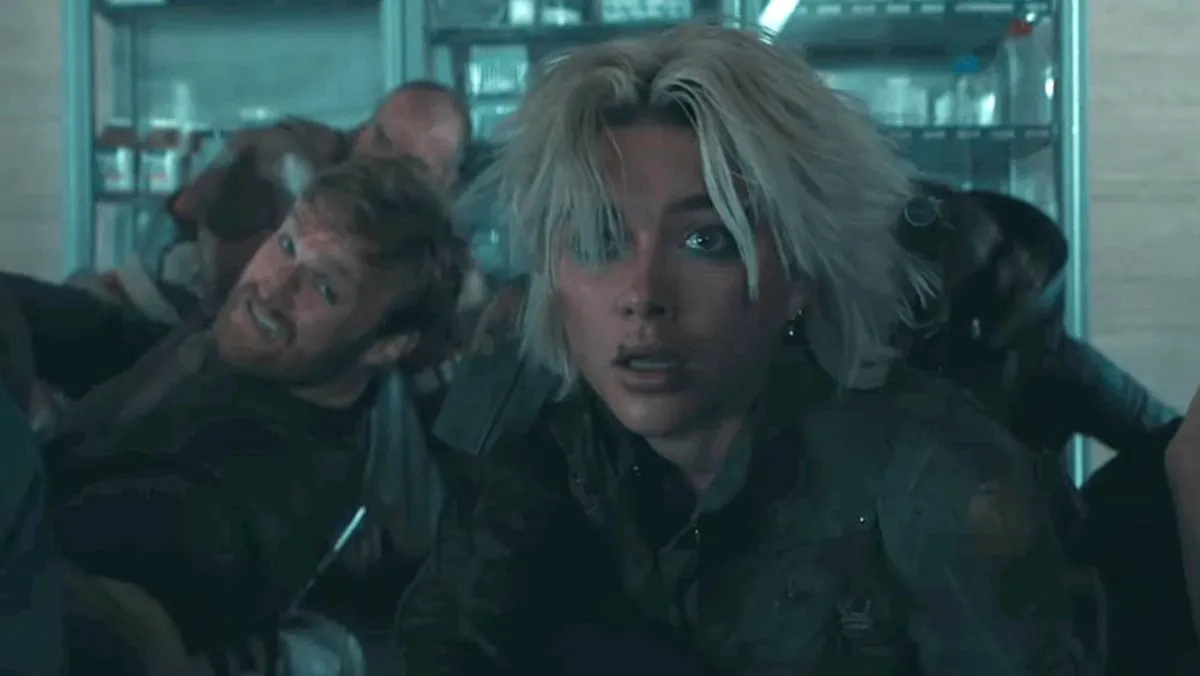
SPOILER ALERT: This article contains significant plot details, including the ending, of Marvel Studios’ “Thunderbolts,” now playing in theaters. The climactic battle in “Thunderbolts” is a groundbreaking moment in the history of Marvel Studios, marking a unique departure from the previous 17 years of storytelling.
Throughout the film, Thunderbolts members experience a surreal phenomenon whenever they make physical contact with Bob Reynolds, portrayed by Lewis Pullman. This interaction pulls them into a vortex of their deepest regrets and memories. For instance, Yelena Belova, played by Florence Pugh, relives the moment she inadvertently lured her friend to her death, a haunting memory from her time in the Red Room. Similarly, John Walker, represented by Wyatt Russell, is confronted with the painful aftermath of his actions during the events of 2021’s “The Falcon and the Winter Soldier,” where he neglected his crying son following his disgrace.
Valentina Allegra de Fontaine, portrayed by Julia Louis-Dreyfus, faces her own trauma: witnessing her father’s murder as a child. These dark recollections are triggered by Bob’s transformation into the formidable superhero Sentry and his self-destructive alter ego, the Void, which threatens to engulf New York City in darkness.
As the plot unfolds, Yelena bravely ventures into the Void, determined to rescue Bob from his "shame room," a manifestation of his abusive childhood. The rest of the Thunderbolts—Bucky (Sebastian Stan), Ghost (Hannah John-Kamen), and Alexei (David Harbour)—support Yelena’s quest by entering the Void to help Bob navigate his traumatic memories. They eventually arrive at a pivotal memory of Bob’s past: the Malaysian science lab where he first volunteered for the experimentation that transformed him into a superhero. Ironically, this is the same lab that Yelena destroys at the film's opening.
In a critical moment, Bob attempts to fight the Void directly, only to find that this confrontation strengthens it. It's not until Yelena and the Thunderbolts embrace Bob and reassure him that he is not alone that he finally escapes the Void, restoring New York City to its former glory.
The visual style of this sequence is notable, employing a handheld, practical aesthetic reminiscent of acclaimed indie films like “Everything Everywhere All At Once” and “Eternal Sunshine of the Spotless Mind.” Director Jake Schreier, known for “Paper Towns” and “Beef,” collaborated with cinematographer Andrew Droz Palermo to create this unique look. Schreier shares insights into the creative process, emphasizing Marvel Studios chief Kevin Feige’s directive to innovate: “Make it different — do it in camera if you can.”
In a recent interview, Schreier discussed the film's deeper themes, including loneliness and mental health. The character of Sentry and the Void were integral to the narrative from the start, providing a platform to explore these pertinent issues. He notes that the story reflects a generation of young men grappling with feelings of isolation and despair, intertwining personal experiences with universal themes.
Schreier elaborated on the creative process behind the "shame rooms." Initially, the concept evolved to showcase the internal struggles of the characters rather than external conflicts. The team, including screenwriter Joanna Calo, delved into the specifics of each character’s shame room, with the goal of evoking empathy and understanding from the audience.
The film concludes with a post-credits scene that sets the stage for the Thunderbolts’ involvement in the upcoming “Avengers: Doomsday.” Although Schreier did not direct this scene, he expressed enjoyment in witnessing its development, indicating a collaborative effort to ensure that the characters transition smoothly into this new narrative arc.
As “Thunderbolts” launches the summer blockbuster season, it intriguingly balances action and emotional depth, challenging the typical superhero narrative. With its themes of shame, loneliness, and redemption, the film aims to resonate with audiences while delivering the action-packed experience expected from a Marvel film. Schreier's vision for the film represents a bold step forward in the ever-evolving landscape of superhero cinema.